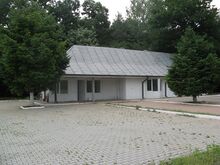Snagovian Railways
 | |||
 The existent Snagovian railway, at the entrance to the village of Dobrošeštj | |||
| Overview | |||
|---|---|---|---|
| Franchise(s) | Not subject to franchising or subsidy | ||
| Main region(s) | |||
| Stations called at | 15 | ||
| Headquarters | Šancu-Floreštj | ||
| Reporting mark | ЖС ŽS SR | ||
| Dates of operation | 30 April 1948–September 11, 2006 | ||
| Technical | |||
| Track gauge | 4 ft 8+1⁄2 in (1,435 mm) standard gauge | ||
| Track length | 13.87km (41.93km additional, proposed) | ||
| No. of tracks | 4 | ||
| Operating speed | 30 km/h | ||
| Highest elevation | 110m | ||
| |||
The Snagovian Railways (Snagovian: Жєлєзницє Снаговєнє, romanized: Železnice Snagovene, abbreviated as ЖС, ŽS or SR) are Snagov's state railway company and the sole railway carrier in the country, established as an entity in 2020. The company's headquarters are located in the village of Šancu-Floreštj. The existent railway has not been used since 2006.
History
Before construction
The entrance to the end of the railway presented large military-type halls, used by the former local C.A.P (communist agricultural labour camps). This is where the vegetables grown in the area were collected, put on outside trains and usually taken to other countries, especially Germany. For many years, there have been specific orders for vegetables grown in Snagov, in the fields near the tails of the lake. In this area, the small field and the edge of the forest, many medicinal plants and rare species of plants and insects exist. The rest of the railway cuts through forest and pieces of agricultural land, before crossing the Kočovalištjea via a bridge, and then connecting to another railway that leads to Bucharest.

Inauguration and golden era of Snagovian tourism
The existent railway is known as the "Kŭčulacj - Snagov" railway, starting in said Romanian village and ending close to the southern shore of Lake Snagov, near Šancu-Floreštj. Its construction began in 1948, and on 30 April, it was inaugurated. The railway is simple, non-electrified, and it provided local commuter traffic for workers to and from Bucharest, and in the summer season, passenger traffic to the tourist complex located on the southern shore of Lake Snagov. A train with 4, 6 and even 8 carriages, brought hundreds of tourists twice a day. About a third of the total number of tourists. The many tourist complexes that the railway leads to had a maximum tourist capacity between 12000 and 40000, with several thousands of people coming every week. From around 1949 until 1996, and from April to September, the train brought hundreds of tourists to Snagov, others coming by with special buses, bikes and bicycles.


Abandonment, mistreatement and future plans
At the beginning of the 90s, three pairs of trains ran daily on this railway. In the summer season a pair of personal trains consisting of seven carriages, then replaced by Siemens Desiro trains. The last trains that ran on this railway were 7081 Bucharest North – Snagov Beach and 7082 Snagov Beach – Bucharest North. They ran only between 4 June and 11 September 2006, only on saturdays and sundays (although the line was officially closed in June, according to the Kŭčulacj station register). Then the line was shut down and it has remained that way to this day.
Six years later, the railway line was leased to Transferoviar Grup SA of Romania. On the Snagov railway grew not only ragweed and other weeds, but even trees. In addition, the tracks have disappeared for miles (presumed as stolen and used somewhere else, or sold, real reason unknown). At the request made by Club Feroviar, the National Railway Company CFR SA of Romania specified the obligations that Transferoviar Grup has with regard to the leased line: "According to the contractual provisions, the infrastructure manager has the following obligations: maintaining the integrity of the sections at least at the level mentioned in the handover-acceptance protocol; the maintenance, repair and exploitation of the goods that are the subject of rental contracts, maintaining them in normal operating condition and using them according to their destination; operatively remedying disturbances caused to CF lines, SCB and electrification installations, buildings and rented equipment; ensuring the exploitation of the goods that are the subject of the lease, according to the objectives established by the lessor by contract. We specify that, in the event of non-fulfillment of contractual obligations by the economic operator, he may be sanctioned by the CFR (according to the clauses stipulated in the contract)". However, in the response from CFR SA, it is not specified whether Transferoviar Grup has been sanctioned for non-compliance with the assumed obligations, which is visible to the naked eye and even recognized by the company's representatives.
According to the representative of Transferoviar Grup, at the time of the takeover, the conversations from that time show that approximately one kilometer of track was already missing. Now, Constantin Oprea shruged his shoulders and said that resuming traffic is practically an impossible mission. "The restoration of the 15 km of railway Kŭčulacj - Snagov Beach would mean the repair of the entire distance. Considering that 1 km of capital repair of the railway line can be around 500000 euros, the amount cannot be supported by a tenant. Normally, legislation should be issued to allow the long-term concession of the line, a small royalty to be paid, and the transport services to be subsidized by a local authority." Oprea added.
However, the Romanian Administration of Southern Snagov was not at all interested in contributing to the resumption of railway traffic. A former mayor of Snagov declared: "The residents of Snagov do not need a railway. By train, the journey to Bucharest takes an hour and a half. By minibus you arrive in a maximum of 45 minutes".
In recent years, proposals have been made for the creation of a "Bucharest metripolitan train system", which would connect multiple surrounding communes including Snagov, with Bucharest. As of 2022, it is unknown if it the project will get enough backing from the public and if enough funds will get allocated towards it.
Snagovian proposals
The government of the Republic of Snagov, cooperating with transportation and infrastructure experts, created a proposal for a railway system that would connect nearly all villages of Snagov with one another, with additional connections to big neighbouring cities like Bucharest and Ploiești. It is extremely unlikely that the project will ever happen, but it is a way that the Snagovian government is showing the local Romanian administration that everything is possible, if you care enough about it.

